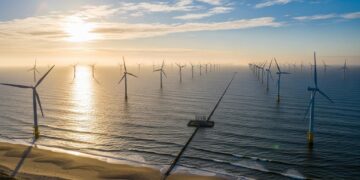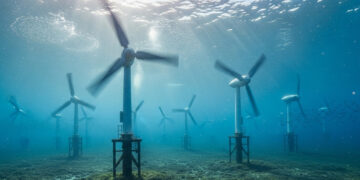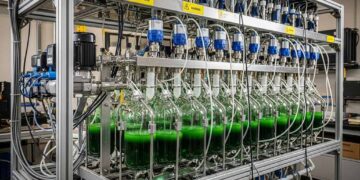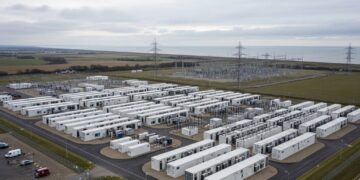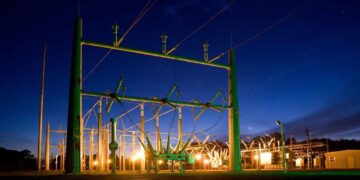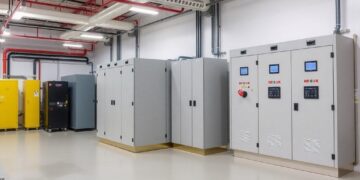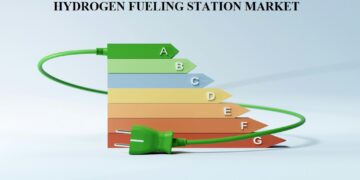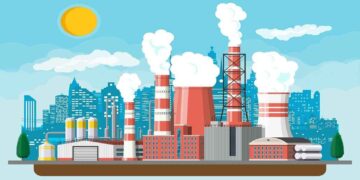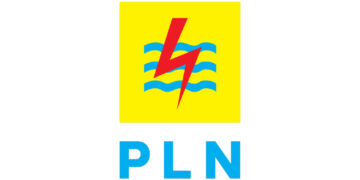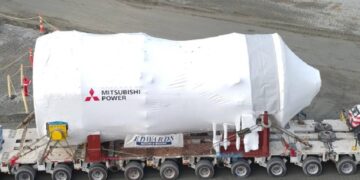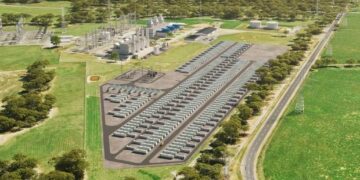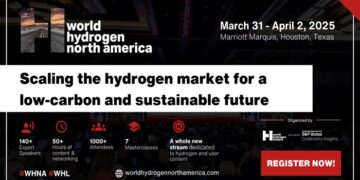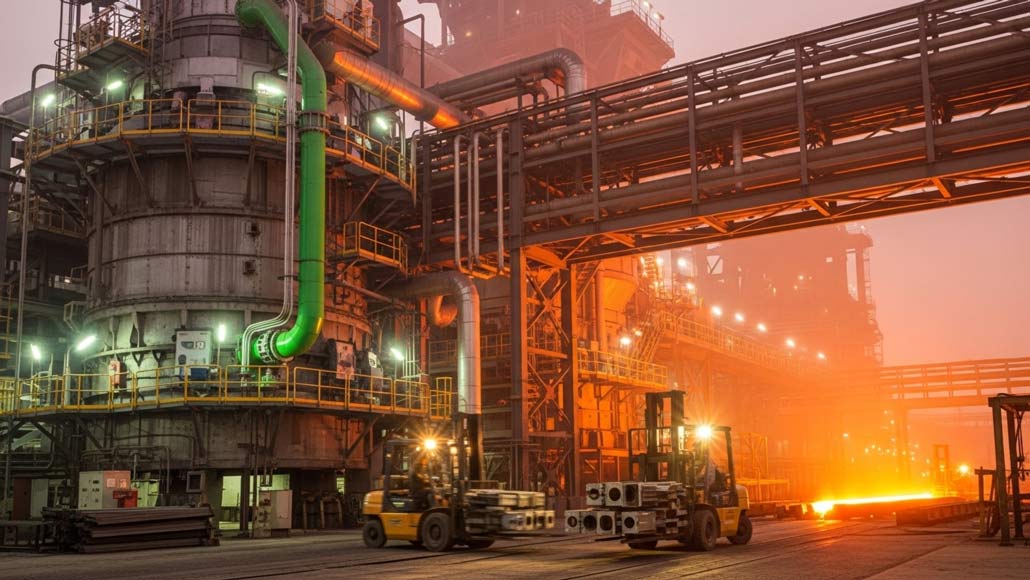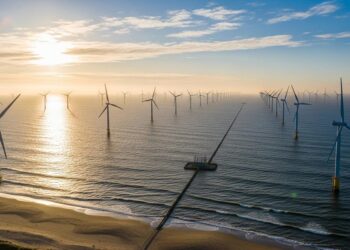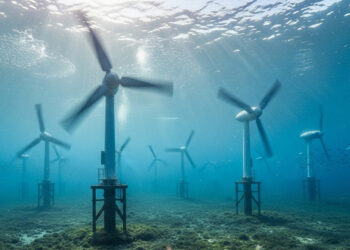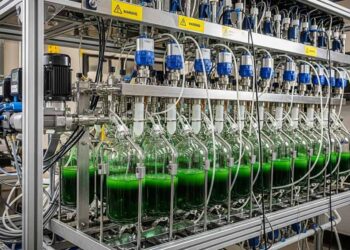Global Hydrogen Power Pilots to Watch 2025–2030: Leading Projects Shaping the Future Energy Economy
The global hydrogen economy enters a defining period from 2025 to 2030, with pioneering hydrogen power pilots emerging worldwide that promise to demonstrate the commercial viability and scalability of hydrogen-based power generation. These demonstration projects represent critical stepping stones toward mainstream hydrogen power deployment, offering real-world validation of technologies, business models, and operational frameworks that will guide industry development for the next decade. The diversity of these hydrogen power pilots spans multiple continents, technologies, and applications, collectively establishing the foundation for hydrogen’s role in future energy systems.
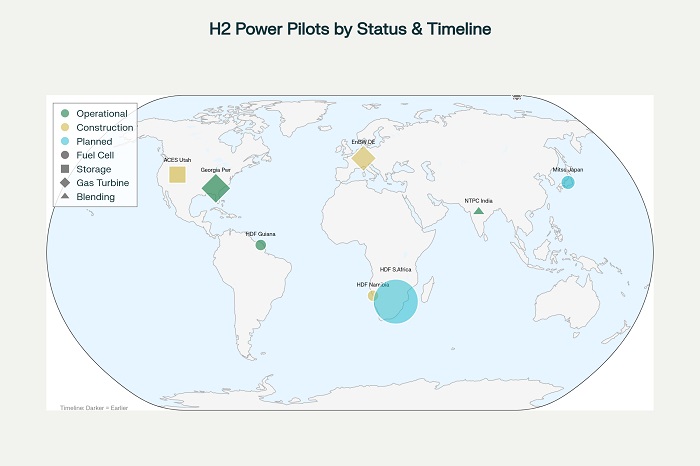
Multi-Megawatt Renewable-Hydrogen Power Plants
The most ambitious category of hydrogen power pilots involves large-scale renewable-hydrogen power plants that demonstrate complete energy systems capable of providing reliable electricity to substantial populations while producing hydrogen for multiple end-uses. These integrated facilities represent the ultimate expression of hydrogen’s potential to enable 100% renewable power systems.
HDF Energy’s global portfolio leads this category with multiple Renewstable projects across six continents, each combining solar photovoltaic generation with hydrogen storage to provide continuous electricity supply. The flagship French Guiana project achieved financial closure in 2021 and now proceeds with construction of the world’s first multi-megawatt hydrogen power plant, featuring 55 MW of solar generation coupled with 16 MW of electrolysis capacity and 128 MWh of hydrogen storage.
The South African Mpumalanga project represents unprecedented scale within this category, planning six interconnected hydrogen power plants with combined 1,500 MW of solar capacity and 3,500 MWh of hydrogen storage. This massive installation will generate 1.9 TWh annually while producing 18,000 tons of hydrogen for industrial applications, demonstrating hydrogen power’s ability to serve major population centers with reliable clean electricity.
Namibia’s Swakopmund project showcases hydrogen power’s potential for supporting economic development in resource-rich regions, combining 85 MW of solar generation with substantial hydrogen production capabilities. The facility will produce 1,400 tons of hydrogen annually while providing electricity for 140,000 inhabitants, establishing hydrogen infrastructure that can support broader industrial development.
Indonesia’s Sumba project represents Asia’s first multi-megawatt hydrogen power plant, designed as a replicable model for implementation across 20 additional locations throughout the Indonesian archipelago. The 30 MW solar installation with 63 MWh of hydrogen storage will serve 35,000 inhabitants while producing 300 tons of hydrogen annually, demonstrating hydrogen power’s applicability to island and remote grid applications.
The Caribbean initiatives, including projects in Barbados, Saint Lucia, and French Guiana, establish hydrogen power as a solution for small island developing states seeking energy independence and climate resilience. These projects combine substantial solar generation with hydrogen storage to provide year-round electricity supply while reducing dependence on imported fossil fuels.
Industrial-Scale Hydrogen Integration Projects
Industrial hydrogen power pilots focus on integrating hydrogen production and utilization within existing industrial facilities, demonstrating how hydrogen can simultaneously decarbonize industrial processes and provide grid services. These projects establish hydrogen as both an industrial feedstock and power generation fuel within integrated energy systems.

The Trinidad & Tobago NewGen project exemplifies industrial hydrogen integration, utilizing low-carbon electricity and waste heat to produce 2.2 tons per hour of hydrogen for ammonia production. This facility demonstrates how existing industrial infrastructure can be adapted to produce clean hydrogen while maintaining current production capabilities, achieving annual carbon savings of 165,000 metric tons.
India’s steel sector pilots represent the largest industrial hydrogen demonstration program globally, with government support of ₹4.55 billion through 2030 for projects testing 100% hydrogen-based direct reduced iron production, hydrogen injection in blast furnaces, and hydrogen blending in existing facilities. These pilots will validate hydrogen’s ability to decarbonize steel production while maintaining production economics and quality standards.
JSW’s pioneering green hydrogen plant in Vijayanagar establishes India’s first steel-integrated hydrogen production facility, designed to produce 3,800 tons annually from late 2025. This project demonstrates the integration of renewable energy, electrolysis, and steel production within a unified industrial complex that maximizes efficiency while minimizing carbon emissions.
European industrial hydrogen pilots focus on integrating hydrogen production with chemical manufacturing and refining operations, leveraging existing hydrogen infrastructure while transitioning from gray to green hydrogen production. These projects demonstrate how existing hydrogen users can transition to clean production methods without disrupting industrial operations.
Advanced Clean Energy Storage in Utah represents the largest industrial-scale hydrogen storage demonstration globally, featuring underground salt cavern storage coupled with renewable energy and fuel cell power generation. This facility establishes the technical and economic viability of seasonal hydrogen storage for grid applications while providing industrial hydrogen supply capabilities.
Transportation and Mobility Demonstration Programs
Transportation hydrogen pilots establish the infrastructure and operational frameworks necessary for hydrogen mobility adoption while demonstrating integration opportunities with power generation systems. These projects create hydrogen demand that can support power sector hydrogen development while validating hydrogen’s performance across diverse transportation applications.
India’s National Green Hydrogen Mission transportation pilots deploy 37 hydrogen vehicles and 9 refueling stations across 10 strategic routes connecting major cities and industrial centers. The ₹208 crore program validates both fuel cell and hydrogen internal combustion engine technologies while establishing hydrogen corridors that can support broader hydrogen economy development.
The program includes major routes such as Greater Noida-Delhi-Agra and Pune-Mumbai, connecting population and industrial centers with hydrogen infrastructure that demonstrates commercial viability. Major industry participants including TATA Motors, Reliance Industries, and NTPC ensure that demonstration results align with commercial deployment requirements.
Japan’s leadership in hydrogen mobility continues expanding with over 5,000 fuel cell buses and taxis already deployed, establishing operational experience that informs broader hydrogen economy development. South Korea’s commitment to 30,000 hydrogen trucks by 2035 creates substantial hydrogen demand that can support power sector applications while validating hydrogen’s performance in heavy-duty transportation.
European hydrogen rail demonstrations, led by Germany’s Coradia iLint fleet that has covered over 100,000 kilometers on hydrogen fuel, establish hydrogen’s viability for railway electrification where conventional electrification remains uneconomical. These projects create consistent hydrogen demand that can support local hydrogen production and storage infrastructure.
California’s $3 billion commitment to hydrogen freight trucks establishes the largest regional hydrogen transportation market globally, creating demand scales that can support dedicated hydrogen production facilities while demonstrating hydrogen’s commercial viability for long-haul trucking applications.
Power-to-X and Synthetic Fuel Demonstrations
Advanced hydrogen power pilots increasingly incorporate power-to-X technologies that convert renewable electricity and hydrogen into synthetic fuels, chemicals, and other products, demonstrating hydrogen’s role in enabling broader economic decarbonization beyond electricity generation.
Green Energy Oman’s 25 GW facility represents the largest announced power-to-X project globally, combining wind and solar generation with seawater desalination to produce 1.8 million tons of green hydrogen annually while generating synthetic fuels including ammonia, methanol, and synthetic diesel. This facility demonstrates how hydrogen can enable complete fossil fuel replacement across multiple sectors.
The Western Australian Renewable Energy Hub combines 26 GW of renewable generation with hydrogen production for both domestic use and export markets, establishing Australia as a major hydrogen exporter while supplying domestic industrial requirements. The project demonstrates how hydrogen can monetize remote renewable resources that exceed local electricity demand.
Kazakhstan’s Hyrasia One project will produce up to 2 million tons of green hydrogen or 11 million tons of green ammonia annually from 40 GW of renewable capacity, establishing Central Asia as a major hydrogen production region while creating export opportunities to both European and Asian markets.
Mauritania’s multiple hydrogen projects, including the unnamed Nouakchott facility and the AMAN project, combine to establish Northwest Africa as a major hydrogen export region serving European markets. These projects demonstrate how hydrogen can enable economic development in resource-rich regions while supplying international clean fuel demand.
The Fleur-de-lys project in Quebec combines 500 GW of offshore wind with hydrogen production for green ammonia, establishing Canada as a major Atlantic hydrogen exporter while creating domestic industrial supply capabilities. Salt cavern storage across 40,000 acres provides the seasonal storage necessary for optimizing renewable energy utilization.
Technology Innovation and Research Pilots
Cutting-edge hydrogen power pilots focus on validating next-generation technologies that promise to improve performance, reduce costs, or enable new applications that will drive broader hydrogen adoption. These projects establish the technical foundation for commercial deployment while identifying optimization opportunities.
RWE’s Lingen pilot plant in Germany demonstrates large-scale electrolysis integration with existing power infrastructure, featuring 14 MW of electrolysis capacity that produces 270 kilograms of green hydrogen hourly. The facility provides operational experience essential for scaling electrolysis to gigawatt levels while demonstrating grid integration capabilities.
High-temperature electrolysis demonstrations at multiple research facilities validate advanced technologies that promise superior efficiency compared to conventional electrolysis. These projects establish the performance characteristics and durability requirements necessary for commercial deployment while identifying materials and operational improvements.
Hydrogen gas turbine demonstrations across multiple countries validate hydrogen’s ability to provide dispatchable power generation that complements renewable energy systems. These projects establish operational parameters, efficiency characteristics, and infrastructure requirements for hydrogen-fired power generation.
Underground hydrogen storage pilots validate multiple geological storage options including salt caverns, depleted gas fields, and aquifer storage that will enable large-scale seasonal energy storage. These demonstrations establish storage capacity, injection and withdrawal rates, and safety protocols necessary for commercial deployment.
Fuel cell technology pilots continue advancing across multiple scales and applications, from distributed generation systems to utility-scale installations that demonstrate hydrogen’s versatility for power applications. These projects establish performance benchmarks, maintenance requirements, and integration capabilities that guide commercial deployment strategies.
Regional Hydrogen Hub Development
Comprehensive regional hydrogen hub developments integrate multiple hydrogen applications within coordinated geographical areas that create synergistic benefits and economies of scale. These projects demonstrate how hydrogen can enable complete regional energy system transformation while supporting economic development and industrial competitiveness.
The United States has allocated $7 billion across seven regional hydrogen hubs that will demonstrate large-scale hydrogen production, storage, and utilization across diverse geographical and industrial contexts. These hubs establish hydrogen infrastructure at scales sufficient to support multiple industrial users while providing grid services and transportation fuel.
European hydrogen valleys integrate renewable energy, hydrogen production, and multiple end-use applications within coordinated regional development programs. These initiatives demonstrate how hydrogen can enable regional energy independence while supporting industrial competitiveness and environmental objectives.
China’s hydrogen demonstration cities create comprehensive testing environments for hydrogen technologies across transportation, industrial, and power applications. These programs validate hydrogen’s performance in diverse climatic and operational conditions while establishing supply chains and supporting infrastructure.
Middle Eastern hydrogen projects leverage abundant solar resources and existing industrial infrastructure to establish major hydrogen production capabilities that serve both domestic and export markets. These projects demonstrate hydrogen’s potential for economic diversification in resource-dependent economies.
Australian hydrogen precincts integrate renewable energy, hydrogen production, and industrial applications to demonstrate complete hydrogen economy development at regional scale. These projects establish export capabilities while supporting domestic industrial development and energy security.
Market Development and Commercial Validation
The most significant hydrogen power pilots focus on validating commercial business models, financing structures, and market mechanisms that will enable broader hydrogen deployment beyond demonstration phases. These projects establish the economic frameworks necessary for transitioning from pilot projects to commercial deployment.
Power purchase agreements for hydrogen-generated electricity establish market pricing mechanisms while providing revenue certainty necessary for project financing. These arrangements demonstrate how hydrogen power can compete commercially with conventional and renewable generation alternatives.
Hydrogen offtake agreements with industrial users create demand certainty that supports project development while establishing market pricing for various hydrogen quality grades and delivery requirements. These arrangements demonstrate how hydrogen can serve industrial markets while supporting power sector development.
Carbon credit monetization demonstrates how hydrogen projects can access additional revenue streams through environmental markets, improving project economics while supporting broader climate objectives. These mechanisms establish hydrogen’s value in achieving corporate and national decarbonization targets.
International hydrogen trade demonstrations establish the logistical, regulatory, and commercial frameworks necessary for global hydrogen markets. These projects validate transportation methods, quality standards, and trade agreements that will enable hydrogen to become a globally traded commodity similar to natural gas or oil.
The convergence of these diverse hydrogen power pilots creates a comprehensive foundation for hydrogen’s emergence as a major energy carrier and power generation fuel. Success across these demonstration projects will validate hydrogen’s technical performance, economic viability, and scalability necessary for mainstream adoption throughout the global energy system.






